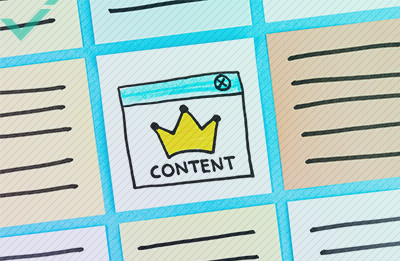B2B (business-to-business) and B2C (business-to-customer) marketing share many similarities. After all, many companies will run marketing initiatives covering both sectors simultaneously. However, try duplicating materials across both B2B and B2C marketing campaigns, and you’ll quickly notice just how different they are. Not only are you catering to distinct audiences, but the needs and expectations differ significantly between these two groups.
To help understand a B2B and B2C marketing strategy, we first need to understand the basics of these two sectors. With that in mind, let’s take a closer look at the definitions of business-to-business and business-to-customer.
What Is B2B?

B2B or business-to-business describes a company that markets and sells directly to other companies. They’ll often spend much more time building a rapport with these companies or addressing a sales representative directly. To succeed in B2B, you need to offer bespoke solutions or products that address a specific need.
- For example, computer software that monitors the productivity of warehouse colleagues. The product is specific to the logistics industry and helps companies improve a key performance metric.
What Is B2C?
B2C, or business-to-customer, is the selling and marketing of products or services from a company directly to consumers. These consumers can vary in their values, needs, and motivations, but they all share a want for particular goods. Because the clientele can differ significantly, marketing materials need to take a much broader approach. Like B2B, you still need an in-depth understanding of your ideal customer, but there’s more flexibility in the scope and effectiveness of said product or service.
- For example, a lifestyle brand that sells clothes, furniture, and digital art. Each of these products appeals to a different audience, but you may find some customers are only interested in the brand rather than the functionality or effectiveness of its products.
![]() B2B and B2C marketing differ significantly despite some similarities. B2B focuses on tailored solutions for companies with specific needs, while B2C targets a broader, diverse customer base, requiring flexible marketing strategies.
B2B and B2C marketing differ significantly despite some similarities. B2B focuses on tailored solutions for companies with specific needs, while B2C targets a broader, diverse customer base, requiring flexible marketing strategies.
The Difference Between B2B and B2C
While there will be overlap between B2C and B2B, a detailed understanding of how these two segments differ, especially in areas such as target audience, sales journeys, and channels, will help ensure the success of your next targeted campaign.
Target Audience

A key difference between B2B and B2C markets is the target audience. The former focuses on select professionals within a specific industry, while the latter could include hundreds or thousands of customers.
Because you typically deal with high-level decision-makers in B2B, interactions need to be far more personalised. You’ll need to ensure your marketing materials can demonstrate the long-term value of your product or service and ease of integration into existing workflows.
With B2C, committing to a product or service is a personal decision. Because you’re targeting a much wider group of potential leads, marketing will be less focused on the specific benefits. That’s not to say you shouldn’t showcase your unique selling points (USPs), but B2C marketing often leverages emotional connections to drive sales.
Products/Services
In B2B, the product or service is typically bespoke or custom to a particular need, solving a problem that’s highly specialised. In a B2C setting, the customer need is entirely different, and you’ll often market a product or service to a much wider audience. As such, these products typically have a range of benefits or uses, although there is still room for specialising, depending on the industry.
Sales Journey

The difference in the target audience and the types of products or services offered directly impact the sales journey. Starting with B2C, many companies will utilise a sales funnel approach, casting a wide net to entice leads into the top of the funnel. Then, as each lead progresses through the sales process, the interaction and marketing typically become more focused and personalised until they finally commit to a sale.
On the other hand, business-to-business takes a more targeted approach from the outset. Rather than targeting numerous leads (usually via social media marketing), B2B services will reach out directly to prospective clients. Moreover, they typically communicate directly with a specific member of the team.
As such, B2B uses personalised and targeted marketing from the first interaction. Businesses may still take a sales funnel approach, increasing contact as each lead gets further through the process. Still, even this is much more involved and personal than the B2C model.
Purchase Decision
In a typical B2C environment, committing to a purchase or service is usually less impactful and monumental than in B2B. That’s not to say you shouldn’t give customers the care and attention they deserve, but there’s usually less convincing needed financially. The decision to buy is driven by an emotional connection to a brand and how that product or service makes the consumer feel.
With B2B, this simply isn’t the case. In most scenarios, the commitment to a product or service is significant, be it the initial cost or the agreement to a long-term contract. As such, that final purchase decision becomes much more involved, and competent sales and marketing teams will need to treat the final stage of the sales funnel with as much focus as all the previous stages combined.
Also, in B2B, follow-up is crucial. In some industries, you may have multiple conversations over several weeks before potential clients commit to a sale.
Relationship

Naturally, carefully encouraging clients to commit to a sale in B2B requires a much closer relationship. Successful B2B marketing requires a deep understanding of the client’s problems and needs from the first interaction. You’ll spend several weeks or months fostering that relationship, often via various marketing channels, including in-person presentations, video calls, trade shows, and more. From start to conversion, the sales cycle in B2B is much longer than that of its B2C counterpart.
However, that doesn’t mean B2C marketing won’t benefit from one-to-one interactions, but is usually reserved for the most loyal customers rather than a default approach. For business-to-customer, the relationship becomes more involved the further a lead progresses through the sales funnel.
Messaging
Messaging in B2C marketing relies on building an emotional connection with customers. How does a product or service address a particular need, how does it make customers feel, and how does it resonate with their core values? Because the sales cycle is much shorter and the relationship is typically less personal, you need to create a lasting impression to ensure they not only commit to a sale but also return in the future.
With B2B, your messaging relies much more on facts and figures: the logical benefits of a business and their impact of key performance metrics. Emotion may still play a part, but the practical implications should be the driving force. You’ll also want to focus on positioning, including the perks of choosing your company over competition. Often, this messaging is bespoke to each client, and marketing materials will need updating accordingly.
Channels

Social media platforms such as Facebook and TiKTok are incredibly powerful channels for B2C marketing. The benefit of business-to-customer marketing is a much wider reach and a significantly greater pool of potential leads. This is both a blessing and a curse, though, as standing out in a sea of advertising requires a carefully planned strategy.
B2B strategies market directly to the end user. As such, you may find some targeted advertising on business-centric platforms such as LinkedIn, but the rest will be sent directly to the company representative. This allows more creative freedom in presenting your USPs, but remember to use industry terminology and to focus on facts and logical reasoning rather than emotional connections.
Customer Service
Interestingly, customer service is one area where the differences between B2B and B2C are minimal. You’ll want to ensure both groups have access to well-trained representatives who focus on problem resolution. This communication also needs to be timely, so having automated replies on social media platforms or escalation routes for ongoing issues is crucial.
Perhaps the one difference between business-to-business and business-to-customer is having a dedicated representative for your B2B partners. Given that your business customers will be operating to strict service level agreements and long-term contracts, it’s imperative they have a clear line of communication for any questions or queries.
![]() B2B and B2C marketing differ primarily in their target audience, products, sales journey, and messaging. While B2B focuses on personalised, fact-driven strategies to build long-term relationships with decision-makers, B2C marketing leverages emotional connections and broad messaging for a wider audience.
B2B and B2C marketing differ primarily in their target audience, products, sales journey, and messaging. While B2B focuses on personalised, fact-driven strategies to build long-term relationships with decision-makers, B2C marketing leverages emotional connections and broad messaging for a wider audience.
Which Is Best: B2B or B2C?
Deciding which is better, B2B or B2C, primarily comes down to your product or service. And, for many companies, there’ll be scope for entering both markets. However, getting started in the B2C sector is undoubtedly easier, as there is a larger pool of potential customers, less time investment needed, and the sales cycle is typically much shorter, so you’ll see returns within weeks rather than months.
The caveat is that B2B marketing has greater returns, and you’ll only need a handful of clients as pricing is more flexible. Moreover, if you already have a corporate background or are familiar with corporate models, a transition to B2B sales is a natural progression. Ultimately, it’s best to consider the above-mentioned differences and decide which sector best suits your capabilities and business goals.


